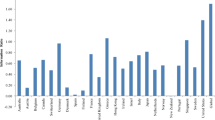Abstract
This study examines the plausibility of the emergence of sunspot equilibria in an agent-based artificial stock market. Using the agent-based model, we make the sunspots explicit so that we can test, e.g., by means of the Granger causality test, whether purely extrinsic uncertainty can influence price dynamics. In addition, through agent-based simulation, the coordination process, which is mainly driven by genetic programming, becomes observable, which enables us to analyze what agents perceive and whether they believe in sunspots. By manipulating different control variables, three series of experiments are conducted. Generally speaking, the chances of observing “sunspot equilibria” in this agent-based artificial stock market are small. However, the sunspot believers can never be driven out of the market. Nevertheless, they are always outnumbered by fundamental believers, which is evidence that the market as collective behavior is rational. We also find that lengthening the time horizon will make it difficult for sunspot believers to survive.
Similar content being viewed by others
References
Bray MM and Kreps DM (1987). Rational learning and rational expectations. In: Feiwl, GR (eds) Arrow and the ascent of modern economic theory. NYU Press, New York
Cass D and Shell K (1983). Do sunspots matter?. J Econ Theory 25: 380–396
Chen S-H and Yeh C-H (2001). Evolving traders and the business school with genetic programming: a new architecture of the agent-based artificial stock market. J Econ Dyn Control 25: 363–393
Chen S-H and Yeh C-H (2002). On the emergent properties of artificial stock markets. J Econ Behav Organ 49: 217–229
Chen S-H and Liao C-C (2005). Agent-based computational modeling of the stock price-volume relation. Inf Sci 170: 75–100
Chen S-H, Yeh C-H and Liao C-C (2002). On AIE-ASM: software to simulate artificial stock markets with genetic programming. In: Chen, S-H (eds) Evolutionary computation in economics and finance, pp 107–122. Physica-Verlag, Heidelberg
Dawid H (1996). Learning of cycles and sunspot equilibria by genetic algorithms. J Evol Econ 6: 361–373
Duffy J and Fisher E (2005). Sunspots in the laboratory. Am Econ Rev 95(3): 510–529
Evans GW and Honkapohja S (1996). Least squares learning with heterogeneous agents. Econ Lett 53: 197–201
Evans GW and McGough B (2005). Stable sunspot solutions in models with predetermined variables. J Econ Dyn Control 29: 601–625
Granger CWJ (1969). Investigating causal relations by econometric models and cross-spectral methods. Econometrica 37: 424–438
Hens T (2000). Do sunspots matter when spot market equilibrium are unique. Econometrica 68(2): 435–441
Hiemstra C and Jones JD (1994). Testing for linear and nonlinear Granger causality in the stock price—volume relation. J Finance 49: 1639–1664
Kajii A (1997). On the role of options in sunspots equilibria. Econometrica 65(4): 977–986
LeBaron B (2001). Evolution and time horizons in an agent-based stock market. Macroecon Dyn 5: 225–254
LeBaron B (2006) Agent-based computational finance. Forthcoming In: Tesfatsion L, Judd KL (eds) Handbook of computational economics, vol 2, Elsevier, North Holland
Marimon R, Spear S and Sunder S (1993). Exceptionally driven market volatility: an experimental study. J Econ Theory 61(1): 74–103
Negroni G (2005). Eductive expectations coordination on deterministic cycles in an economy with heterogeneous agents. J Econ Dyn Control 29: 931–952
Tesfatsion L, Judd KL (ed) (2006). Handbook of computational economics, vol 2. Elsevier, North Holland
Woodford M (1990). Learning to believe in sunspots. Econometrica 58: 277–307
Author information
Authors and Affiliations
Corresponding author
Rights and permissions
About this article
Cite this article
Chen, SH., Liao, CC. & Chou, PJ. On the plausibility of sunspot equilibria. J Econ Interac Coord 3, 25–41 (2008). https://doi.org/10.1007/s11403-008-0037-3
Published:
Issue Date:
DOI: https://doi.org/10.1007/s11403-008-0037-3




